Vegetables
CABBAGE EVERYWHERE?
I have always been a great fan of cabbage. Normal cabbage is lovely and heavenly when early, the taste of Brussels sprouts is totally irresistible, broccoli is full of green power and I have produced barrels of sauerkraut. But I haven’t grown much cabbage before except curly kale. I have usually let the experts look after that and thought that it needed a very nutritious soil and needed too many pesticides. Everyone likes cabbage and all that is left for the grower are the thick nerves from the leaves. The Brassica family is huge and when we started growing greens for the catering companies we just had to try growing it ourselves. Curly kale was the beginning even though the first years sowings only cropped towards autumn when frost took care of the pests. Cabbages need a lot of feeding which led us to plans of soil-improvement, Bokashi and mulching.
Last years plantings of curly kale succeeded relatively well and Red Russian gave a surprisingly big crop for several months. We patiently used a protective fleece until September to keep the pests under control. Repeated cropping taxed the strength of the plants towards the end of the harvest period. Future plantings must be given extra nutrition in the form of Bokashi, nettle watering and green manures. For next year the most important variety will be kale but as something new we’ll also try spring cabbage ( a conical variant of cabbage). The Swedish gardener and writer, Lena Israelsson convinced us to try it out and she values it highly as an early crop. This applies especially to the red form Kalibos which was thought to be lost. It is best freshly harvested in salads. It is supposed to be good as sauerkraut as well. Other cabbage varieties of note are Tuscan kale and the exciting broccolini.
We will grow the cabbage in the poly-tunnel with marigolds. It’s very inspiring to wait and see if it works.
An Asiatic head-over-heels
I confess that I have long been completely ignorant,not to say even grudgingly abrasive, about Asiatic green vegetables (and even other food). The Asian culture hadn’t fascinated me and I didn’t think that their green veg would appeal to me either. Luckily I was wrong.
The first trials with Asiatic greens were doubtful. It was when we first grew Chinese mustard and Mizuna intensively in a pallet collar and under fleece that the properties and taste of the varieties became apparent. Lovely fine leaves quickly and in great abundance. Last year we made the first summer sowing of Tatsoi, Daikon, Komatsuna and Pak Choi. The result wasn’t overwhelming but it do show that it was worth repeating. Our goal is to at least have Daikon or winter radish next season. This is suitable for making the Korean dish Kimchi which, as a friend of sauerkraut, must taste. We will be growing other wonders from the East such as garlic chives, which has been a favourite since my garden schooling days, kale Red Russian, lovely and soft with a great taste, Shungiku or garland chrysanthemum and Malabar spinach have been grown in the pallet collars for some time.

The most wonderful and most challenging thing is to sow them at exactly the right time in other words to adapt them to the early seasons veg regimen and to changeable weather. They can’t be sown too early because the prolonged daylight of the Finnish season does not favour plants primarily adapted to shorter daylight hours. Another difficulty is that most of these wonderful plants are members of the cabbage family and therefore suffer from the same pests. Cabbage netting or fleece is completely necessary.
ASPARAGUS
We planted the first asparagus in 2017. The variety was Xenolim. We dug a deep ditch where we planted the plants or, strictly speaking, the roots one after the other and then covered. There was plenty of room beside the asparagus at the time where we had also planted Jerusalem artichokes. Things stared to escalate as the artichokes started to wander, as they do, growing bigger and bigger. After a lot of work and on many occasions, we dug up all the artichokes and extended the asparagus bed by 50%. At the base of this extended asparagus bed we put in bokashi compost which we had just started making by fermenting our kitchen waste. The results were astounding. The new bed grew with great speed, phenomenally quick. The difficult thing with growing asparagus is to let it tick over the first two years and leave it alone. The roots need to establish themselves properly before you can begin to harvest. We remodelled the bed in the spring of 2020 and grew radishes as an intermediary culture which worked well, but less well with kohlrabi.
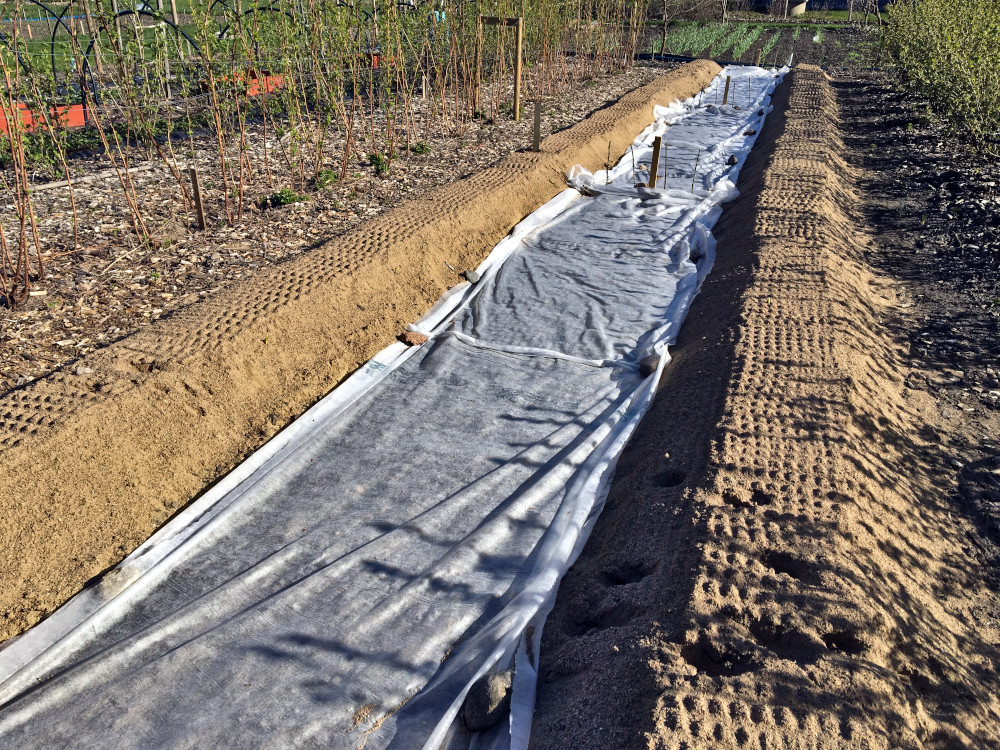
THE YEAR OF THE PUMPKIN 2021
This is fantastic news! I swear I did not know about it before when in November 2020 I planned crop cycling and worked out that we need more area to grow cabbages. We started to make new beds directly on the grass. I was thinking of growing pumpkins in them next summer. Then I found Swedish author, Lena Israelsson’s book Gourmetträdgården and the web pages of Runåbergs frö. Then I got carried away.
We have grown squash before, tried and fallen in love with Kabocha squash and harvested some winter squash from the compost heap. But there are so many colours, shapes and flavours of winter squash all of which are well suited to baking in the oven, making soups or vegetable stews… I have a vague recollection from childhood of conserved pumpkins which were sickly sweet and with an awful consistency. I didn’t like the compulsory cloves either. But pumpkin can be something completely different! How infuriating. Squash does not have to be a tasteless raw material whose one good property is a huge harvest. Squash is allowed to taste like – squash.. This is how one variety Costata Romanesco, which we shall grow next season, is presented. Its taste and productivity is excelled by none and it gets a special mention for it’s many, large male flowers. The luxury of harvesting fingersized fruits complete with flowers is the luxury of eating them when they taste best.
All in all, we be having 16 different varieties between two 40 meter beds. The old saying that not everything will germinate or grow and produce fruit is probably true, but I’m sure that something will grow. I can hardly wait.
New for this year: TALLBACKA MIX
During 2021 we became acquainted with Charles Dowding’s NO-DIG method and teaching. This has not only resulted in great changes in how we grow, but also our thoughts about what we would like to grow. It wasn’t long ago that I thought that growing salad was unnecessary as beautiful wild greens grow all everywhere. However the move from the well known edges of the fields of my childhood changed my way of thinking as it’s not so easy to know where I can find them nowadays. Trying out Dowding’s way to grow salad changed my mind.
The big news for the 2022 season is a salad blend, TALLBACKA MIX! Dowding’s method makes it possible to harvest continually and that’s why so many salad varieties are on offer. We are now thinking of a salad blend which changes taste, colour and structure during the seasons from spring to autumn. Some varieties are new to us but the base is Romaine lettuce (Cos), plants from the cabbage family and spinach. There are different kinds of perennials such as sour tasting plants like the sorrels, the sedums and Caucasian spinach. Most of the varieties have a mild taste but there are a few piquant surprises like wasabino, wild rocket, mustard and watercress. The blend can also contain quite unknown varieties for Finland such as plants from the genus Amaranthus and mitsuba and salad burnet which many know as a herb. We will concentrate on the appearance and structure of the mix and gather a good-looking, crispy and juicy salad blend.
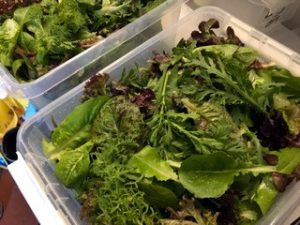
Vegetable of the year: Tomato
Gardening circles in Finland have just announced the tomato as vegetable of the year. This is great as Tallbacka joins them in this regard even though it isn’t one of our top products.
In 2021 we harvested our first tomatoes from the new greenhouse. The summer heatwave gave us temperatures in the greenhouse too high for optimal growth but the tomatoes survived. In reality they managed to stay relatively healthy into the autumn’s colder weather. The heatwave only stopped development in July.
We have sourced the following varieties for the 2022 season:
- SUNGOLD – a lovely sweet golden cherry tomato.
- TIGERELLA – red and yellow stripes
- ZLATAVA – reminds you of a blood orange with a yellow skin and red inside
- ILDI – a bright orange cherry tomato
- NARANJA – means orange
- MEILI de NUHAI – meaning ‘ beautiful girl’ a Chinese variety loved by Lena Israelsson
- SAN MARZANO – the classical Italian pasta tomato
These will probably be updated later with impulse-buys. My reason is sometimes affected when I’m standing near to the seed displays.
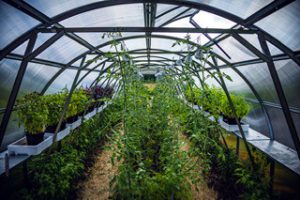
The story of the beetroots
We will also be investing in root vegetables in 2022. One of the reasons is that I love oven-baked root vegetables, another being that our customers have responded well to them as have Charles Dowding’s advice on growing. In 2021 we grew the roots in plugs and planted them out in clusters. Yellow and white beetroots and daikon worked really well like this. The round types of normal red beetroot worked as well but the longer varieties were a failure. We will continue to develop this system next year. It should be important to get the first plants planted early and under fleece so they have time to mature before harvest at midsummer. After that new plants can be planted out immediately. This is one of the good features with NO-DIG. The planting beds are ready immediately, they don’t need ploughing, cultivating, feeding or even weeding. Any seed sown weeds are removed during the season or removed when still small.
The plan is to let the beetroots grow in the newest beds. As early as is possible in spring we will plant early turnips (Snowball, Goldana and Purple Top Milan) and different varieties of radish. Daringly I am thinking of trying an early variety of beetroot Alvro Mono and the Chinese winter radish Red Meat. Early carrots are also needed and will be Amsterdam Forcing. The strange idea -and they are needed – is to grow the ancient and ugly but stupendously tasting beetroot Crapaudine. If everything goes our way we will be tasting it on St. Olof’s day July 29th. After midsummer we will be planting more beetrots of the red, yellow and white kind as well as swedes and winter radish Daikon.
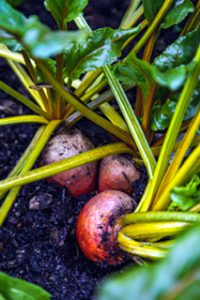
Chili peppers, a taste sensation
We bought our first plastic tunnel greenhouse in 2020. We wanted to try our hand at growing tomatoes, chili peppers and aubergine. These are plants that need extra warmth and shelter to thrive. We became so enthusiastic that the following autumn we built a new greenhouse, this time with 6 mm polycarbonate and an area of 30 m².
In the spring 2021 we sowed many varieties of tomatoes and chili peppers which were then planted out in the new greenhouse. These were partly old acquaintances from our first year such as Anaheim, Cayennetta, Thai Hot Red and Padron, but also new exciting varieties likeHot Lemon, Bulgarian Carrot, Tabasco and Buena Mulata. Unfortunately the summer heat was in excess and growth stopped for a while during the hottest period. The chili peppers, however, survived and started producing fruit later in the summer. Early frosts made the season a little too short and a large proportion of the chili peppers didn’t quite ripen. Next season we plan to have sun shades in place to reduce the temperature so I think that the result will be better.
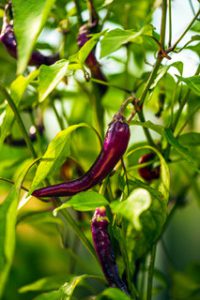
The taste of chili peppers is easy to fall for. It’s not just about the Scoville scale but the different aromas of different varieties. They provide the sting that enhances the taste of stews and salads.